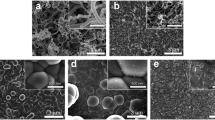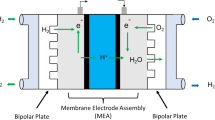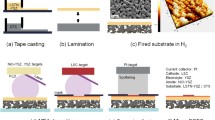Abstract
Hydrogen fuel cells offer a clean and sustainable energy conversion solution. The bipolar separator plate, a critical component in fuel cells, plays a vital role in preventing reactant gas cross-contamination and facilitating efficient ion transport in a fuel cell. High chromium ferritic stainless steel with an artificially formed thin chromium oxide passive film has recently gained attention due to its superior electrical conductivity and corrosion resistance, making it a suitable material for separators. In this study, we investigate the microscopic electrical conductivity of the intrinsic passive oxide film on such ferritic stainless steel. Through advanced surface characterization techniques such as current sensing atomic force microscopy and scanning tunneling microscopy/spectroscopy, we discover highly conductive regions within the film that vary depending on location. These findings provide valuable insights into the behavior of the passive oxide film in fuel cells. By understanding the microscopic electrical properties, we can enhance the design and performance of separator materials in hydrogen fuel cells. Ultimately, this research contributes to a broader understanding of separator materials and supports the wider application of hydrogen fuel cells.




Similar content being viewed by others
References
A. Schäfer, J.B. Heywood, M.A. Weiss, Energy 31, 2064 (2006)
Z. Xu, D. Qiu, P. Yi, L. Peng, X. Lai, Prog. Nat. Sci. Mater. Int. 30, 815 (2020)
Q. Liu, F. Lan, C. Zeng, J. Chen, J. Wang, J. Power Sources 538, 231543 (2022)
P. Yi, X. Li, L. Yao, F. Fan, L. Peng, X. Lai, Energy Convers. Manag. 183, 65 (2019)
A. Kraytsberg, M. Auinat, Y. Ein-Eli, J. Power Sources 164, 697 (2007)
Y. Leng, P. Ming, D. Yang, C. Zhang, J. Power Sources 451, 227783 (2020)
S. Karimi, N. Fraser, B. Roberts, F.R. Foulkes, Adv. Mater. Sci. Eng. 2012, 828070 (2012)
R.A. Antunes, M.C.L. Oliveira, G. Ett, V. Ett, Int. J. Hydrog. Energy 35, 3632 (2010)
C. Turan, Ö.N. Cora, M. Koç, Int. J. Hydrog. Energy 36, 12370 (2011)
N. Shaigan, X.-Z. Yuan, F. Girard, K. Fatih, M. Robertson, J. Power Sources 482, 228972 (2021)
C.O.A. Olsson, D. Landolt, Electrochim. Acta 48, 1093 (2003)
N. De Cristofaro, M. Piantini, N. Zacchetti, Corros. Sci. 39, 2181 (1997)
J. Kim, K. Jo, Y. Kim, J. Lee, Y. Lee, J. Kim, J. Seok, U.S. Patent 11047029 B2 (2021)
Y. Leng, D. Yang, P. Ming, B. Li, C. Zhang, World Electr. Veh. J. 12, 101 (2021)
F.J. Giessibl, Rev. Mod. Phys. 75, 949 (2003)
F. Houzé, R. Meyer, O. Schneegans, L. Boyer, Appl. Phys. Lett. 69, 1975 (1996)
F. Hui, M. Lanza, Nat. Electron. 2, 221 (2019)
G. Binnig, H. Rohrer, Rev. Mod. Phys. 59, 615 (1987)
P.K. Hansma, J. Tersoff, J. Appl. Phys. 61, R1 (1987)
R.M. Feenstra, Surf. Sci. 299–300, 965 (1994)
U.S. DOE, Hydrogen and Fuel Cell Technologies Office Multi-Year Research, Development, and Demonstration Plan (2014)
L. Jiang, J. Weber, F.M. Puglisi, P. Pavan, L. Larcher, W. Frammelsberger, G. Benstetter, M. Lanza, Materials 12, 459 (2019)
J. Weber, Y. Yuan, F. Kühnel, C. Metzke, J. Schätz, W. Frammelsberger, G. Benstetter, M. Lanza, A.C.S. Appl, Mater. Interfaces 15, 21602 (2023)
M.A. Lantz, S.J. O’Shea, M.E. Welland, Rev. Sci. Instrum. 69, 1757 (1998)
X. Ji, J. Oh, A.K. Dunker, K.W. Hipps, Ultramicroscopy 72, 165 (1998)
O. Stukalov, C.A. Murray, A. Jacina, J.R. Dutcher, Rev. Sci. Instrum. 77, 033704 (2006)
L. Zitzler, S. Herminghaus, F. Mugele, Phys. Rev. B 66, 155436 (2002)
Y. Ji, F. Hui, Y. Shi, T. Han, X. Song, C. Pan, M. Lanza, Rev. Sci. Instrum. 86, 106105 (2015)
D.-Z. Guo, S.-M. Hou, G.-M. Zhang, Z.-Q. Xue, Appl. Surf. Sci. 252, 5149 (2006)
T.D.B. Jacobs, A. Martini, Appl. Mech. Rev. 69, 060802 (2017)
S.A. Sumaiya, A. Martini, M.Z. Baykara, Nano Express 1, 030023 (2020)
T. Ahn, S. Song, U. Ham, T.-H. Kim, Rev. Sci. Instrum. 94, 063702 (2023)
T. Souier, M. Chiesa, J. Mater. Res. 27, 1580 (2012)
M.C. Lin, G. Wang, L.Q. Guo, L.J. Qiao, A.A. Volinsky, Appl. Phys. Lett. 103, 143118 (2013)
L.Q. Guo, M.C. Lin, L.J. Qiao, A.A. Volinsky, Corros. Sci. 78, 55 (2014)
S. Kremmer, S. Peissl, C. Teichert, F. Kuchar, H. Hofer, Mater. Sci. Eng. B 102, 88 (2003)
A. Bietsch, M.A. Schneider, M.E. Welland, B. Michel, J. Vac. Sci. Technol. B 18, 1160 (2000)
B. Voigtländer, Scanning Probe Microscopy: Atomic Force Microscopy and Scanning Tunneling Microscopy (Springer, Berlin, 2015)
Acknowledgements
This work was supported by POSCO Steel & Green Science (2019Y081). We gratefully acknowledge the assistance of Jungsub Lee and Jeehoon Kim in conducting the CSAFM experiments.
Author information
Authors and Affiliations
Corresponding author
Additional information
Publisher's Note
Springer Nature remains neutral with regard to jurisdictional claims in published maps and institutional affiliations.
Appendix
Appendix
1.1 Current sensing atomic force microscopy (CSAFM)
To explore the local conductivity of our ferritic stainless steel samples, we utilize CSAFM, which combines current measurements with contact mode AFM imaging. In general, CSAFM operates under the standard AFM contact mode, using cantilevers coated with a conductive film [16, 17]. By integrating current measurements with contact mode AFM imaging, CSAFM serves as a powerful and effective method for investigating microscopic conductivity variations within resistive samples. When a bias voltage is applied between the sample and the conducting cantilever, a current is induced (Fig. 1a), enabling us to obtain a spatially resolved conductivity image. CSAFM provides concurrent information on the spatial distribution of current and the sample topography with a constant cantilever load and bias voltage. Furthermore, the measured current can be adjusted by varying the bias voltage and/or cantilever load.
For our specific experiments, we employ a commercial AFM with solid Pt probe tips, chosen for their ability to resist the degradation frequently encountered with metal-coated probe tips [22,23,24]. These probes, featuring a force constant of 18 N/m and a typical radius of less than 20 nm, allow for precise microscopic conductivity measurements.
We frequently encountered issues with unreliable current maps when using low normal forces. This phenomenon can be attributed to the inevitable presence of a water layer between the metal probe tip and sample in ambient conditions. The water layer results in the reduced electric field confinement near the tip-sample junction, causing an unstable current flow during the measurement process [22, 36]. To achieve stable current in CSAFM measurements under ambient conditions, it is imperative to apply a higher contact force to break the water layer [22]. In our study, we utilized a relatively high normal force of 400 nN in ambient conditions to guarantee highly reliable electrical contacts between the conducting tip and the sample during the process of current mapping [37].
Crucially, CSAFM allows for the simultaneous visualization of topography and current distribution, offering invaluable insights into the conductive characteristics of the passive film across different regions of the sample. However, as with any experimental method, CSAFM has limitations, such as the potential for tip wear and degradation, and possible disruptive influence on the sample surface [22, 25,26,27,28,29,30,31]. These factors can result in inconsistent or inaccurate measurements over time. To minimize these effects, we conducted our experiments under controlled humidity conditions, maintaining a relative humidity of less than 30%. Additionally, we utilized N\(_2\) gas flow to further decrease the humidity (\(<9\)%) [28].
For a more in-depth analysis, we measured representative current–voltage I(V) curves in regions of the passive film exhibiting higher conductivity in the concurrently obtained current map and topographic image. Each point I(V) curve was derived from an average of more than ten individual measurements taken at a fixed position. This approach ensured the reproducibility and consistency of the observed I(V) characteristics, enhancing the reliability of our findings.
1.2 Scanning tunneling microscopy (STM)
To further enhance the analysis of our ferritic stainless steel samples, we expanded our methodology to include STM [19]. This advanced technique provides atomic-level surface scrutiny, mitigating the limitations associated with CSAFM. STM involves bringing an atomically sharp metallic tip into close proximity with the sample surface (approximately 1 nm) (Fig. 1b). When a bias voltage is applied between the tip and the sample, electrons tunnel through the vacuum barrier, generating a tunneling current that depends on the tip-sample distance, applied bias voltage, and the local DOS of the sample. We performed STM measurements in the constant current mode using an electrochemically etched PtIr tip in a home-built STM under UHV conditions (\(P<1.0\times 10^{-10}\) Torr) at room temperature [32].
To refine our analysis, we incorporated STS, an advanced technique of STM [20, 38]. STS records the tunneling current response to varied bias voltages while maintaining a constant sample-tip distance. This non-invasive method enables us to obtain the local DOS of the sample, investigating its intrinsic electronic properties with atomic precision—an advantage over CSAFM. Combined with STM scanning mode, STS produces spatially resolved local DOS maps, providing detailed insights into the local electronic properties of the sample. In this study, we obtained differential tunneling conductance (dI/dV) spectra using a lock-in amplifier that modulated the bias voltage by 30 mV at a frequency of 997 Hz.
While STM requires atomically clean and stable surfaces, strong vibration isolation, and high-performance electronics, it offers extraordinary spatial precision and unmatched atomic-level insights in terms of precision and detail. The combined use of STM and STS is instrumental in our investigation of the local conductivity of our ferritic stainless steel samples.
Rights and permissions
Springer Nature or its licensor (e.g. a society or other partner) holds exclusive rights to this article under a publishing agreement with the author(s) or other rightsholder(s); author self-archiving of the accepted manuscript version of this article is solely governed by the terms of such publishing agreement and applicable law.
About this article
Cite this article
Ahn, T., Kim, TH. Microscopic conductivity of passive films on ferritic stainless steel for hydrogen fuel cells. J. Korean Phys. Soc. 83, 289–295 (2023). https://doi.org/10.1007/s40042-023-00878-8
Received:
Revised:
Accepted:
Published:
Issue Date:
DOI: https://doi.org/10.1007/s40042-023-00878-8




